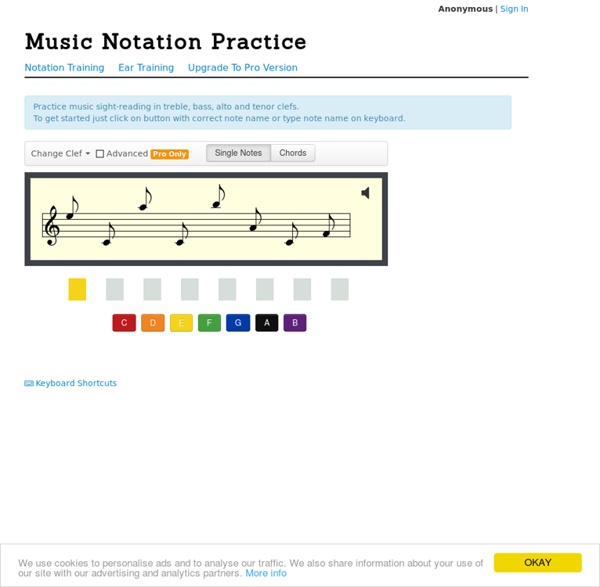



make music together let's get started making music... 1draw on the grid with your mouse to make a beatshow me2 save your track and share it with friends. show me3 out of ideas? roll the dice and start remixing. show me4 explore the beatlab community show me For more tips, tutorials vidoes, and FAQs, check out our community wiki. You can use the following keyboard shortcuts while composing a track.
7th Chords on the piano - Week Ten - One of the most valuable chord types you'll ever learn... Hello again, and welcome to the next edition of the newsletter. I hope you are enjoying learning about all the chords in the world -- and we're going to cover them ALL before we're done -- you'll know more about chords than 99% of the people in the world -- believe it or not, it's true. If you recall the first week we learned about the three chords you absolutely, positively CAN'T do without.
Dolmetsch Online - Music Theory Online - Ear Tests and Drills Ear Tests and Drills :: For 'clean' or 'blank' manuscript/staff paper (also called score paper) Manuscript/staff paper Ear test and drill resources, maintained off the Music Theory Online site, we believe to be accurate but we are not responsible for any errors. Sites that give helpful hints about how to approach acquiring aural skills, although no actual exercises are included.
How to construct chords - Piano Clues: Free tips and lessons for playing piano, organ and electronic keyboard You don’t need a “1000 Chords Dictionary” to be able to read and play chords. You can learn how to form chords on your own, because chords are built using simple formulas. A chord is three or more notes played at the same time. It’s as simple as that. Of course, the trick is to know which three notes… Tools for Teaching A preview of Smithsonian Folkways on iTunes U. Click the image to launch iTunes on your computer. Smithsonian Folkways is committed to offering educational materials to complement the music on our site.
ButtonBeats Virtual Guitar Beatles - Here comes the sun [#U@c]Un$U$nU[bvcPE]U[bn]U[bv!x]#b#U[n#] [U@c]$Un$Un$U[bvcPE]$nU[#v!x] [U@c]$n$U$Un$[bvcPE]$n$[U*cP0] [U@c]$nU @LUn@UnvUn@UnU#b@ [#U@c]Un$U$nU[bvcPE]U[bn]U[bv!x]#b#U[n#] [U@c]$Un$Un$U[bvcPE]$nU[#v!x] [U@c]$n$U$Un$[bvcPE]$n$[U*cP0] [U@c]$nU @LUn@UnvUn@UnU#b@ [U@c]$Uv@[bv! Leçons gratuites de guitare Complete list of lessons and pages on this site. Related YouTube videos will have an index number in the name of the video - so just look for that number below and you should find everything ok :) Or you could use the seach box above, but many times a big list like this seems to be easier! Quick Skip to Prefix Anchors Just click on the prefix below and it will zoom you down the page to that area!
Integrated Aural Skills Welcome Introduction to Aural Skills Introduction to Intervals Introduction to Diatonicism Introduction to Melodic Dictation Introduction to Seventh Chords Learning and Loving Music Theory Kelvin, You actually caught a mistake on the roman numerals! Thanks, I’ll have to fix that. Philharmonia Orchestra Here, the Philharmonia's expert players guide you through the intricacies of the instruments they play. Choose an instrument from one of the sections. The string section is the basis of the orchestra and the one consistent component of orchestras down the ages. The range of expression available and the great stamina of strings makes them a powerful tool. The Principal of the First Violin section is also the Leader of the orchestra.